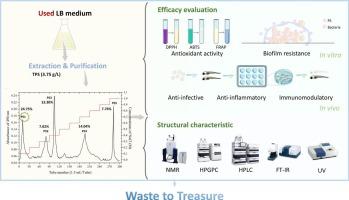从废培养基中提取多糖作为功能成分
Q1 Environmental Science
引用次数: 0
摘要
发酵后培养基是一种未充分利用的资源,含有大量的生物活性多糖。为了克服传统提取技术能耗高、污染环境、结构降解等缺点,本研究采用了条件温和、溶剂可重复使用、生物活性保存良好的绿色乙醇沉淀法。废培养基的多糖总得率为3.75 g/L。经离子交换层析纯化后,多糖组分PS1显示出显著的生物学特性。对感染金黄色葡萄球菌和荧光假单胞菌的斑马鱼具有抗菌作用,在1 mg/mL浓度下,对生物膜形成的抑制作用分别为40.86%和29.04%,并表现出抗氧化能力。PS1由甘露糖、n -乙酰氨基葡萄糖和葡萄糖组成,经HPLC确证,并通过FT-IR和NMR进一步对其结构进行了表征。本文首次报道了从该废弃物中提取多糖并进行生物活性评价,为发酵后残留物的循环利用和资源保护提供了一种可持续的策略。本文章由计算机程序翻译,如有差异,请以英文原文为准。

Extraction of polysaccharides from waste medium as functional ingredients
The post-fermentation culture medium, an underutilized resource, contains substantial amounts of bioactive polysaccharides. To overcome the drawbacks of conventional extraction techniques such as high energy consumption, environmental pollution, and structural degradation, this study adopted alcohol precipitation, a green method offering mild conditions, solvent reusability, and preserved bioactivity. A total polysaccharide yield of 3.75 g/L was obtained from the waste medium. Following purification via ion-exchange chromatography, the polysaccharide fraction PS1 demonstrated significant biological properties. It exhibited antibacterial effects in zebrafish infected with Staphylococcus aureus and Pseudomonas fluorescens, inhibited biofilm formation by 40.86 % and 29.04 % at 1 mg/mL, respectively, and displayed antioxidant capacity. PS1 consisted of mannose, N-acetylglucosamine, glucose confirmed by HPLC and its structure was further characterized by FT-IR, and NMR analysis. As the first report on the extraction and bioactivity assessment of polysaccharides from this waste source, our work offers a sustainable strategy for recycling post-fermentation residues and advancing resource conservation.
求助全文
通过发布文献求助,成功后即可免费获取论文全文。
去求助
来源期刊

Bioresource Technology Reports
Environmental Science-Environmental Engineering
CiteScore
7.20
自引率
0.00%
发文量
390
审稿时长
28 days
 求助内容:
求助内容: 应助结果提醒方式:
应助结果提醒方式:


